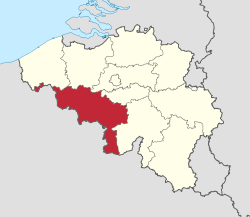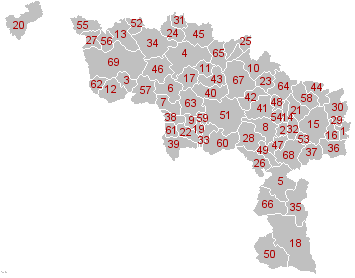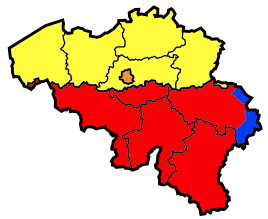Hainaut Province
Hainaut (/eɪˈnoʊ/, also US: /heɪˈ-, ɛˈ-/, UK: /ˈ(h)eɪnoʊ/,[4][5][6] French: [ɛno]; Dutch: Henegouwen [ˈɦeːnəɣʌuə(n)] (![]()
Hainaut Heynowes | |
|---|---|
 Flag .svg.png) Coat of arms | |
 | |
| Coordinates: 50°30′N 3°55′E | |
| Country | |
| Region | |
| Capital | Mons |
| Largest city | Charleroi |
| Government | |
| • Governor | Tommy Leclercq |
| Area | |
| • Total | 3,813 km2 (1,472 sq mi) |
| Population (1 January 2019)[2] | |
| • Total | 1,344,241 |
| • Density | 353/km2 (910/sq mi) |
| HDI (2017) | 0.876[3] very high · 11th |
| Website | www |
To its south lies the French department of Nord, while within Belgium it borders (clockwise from the North) on the Flemish provinces of West Flanders, East Flanders, Flemish Brabant and the Walloon provinces of Walloon Brabant and Namur.
Its capital is Mons (Dutch Bergen) and the most populous city is Charleroi, the province's urban, economic and cultural hub, the financial capital of Hainaut and the fifth largest city in the country by population. Hainaut has an area of 3,831 km2 (1,479 sq mi) and as of January 2019 a population of 1,344,241.[7]
History

The province derives from the French Revolutionary Jemmape department, formed in 1795 from part of the medieval County of Hainaut, the small territory of Tournai and the Tournaisis, a part of the county of Namur (Charleroi), and also a small part of the Prince-Bishopric of Liège (Thuin). (A large part of the historical county of Hainaut is now within France and sometimes referred to as French Hainaut.)
Subdivisions

Hainaut province is divided into 7 administrative districts (arrondissements), subdivided into a total of 69 municipalities. It has an area of 3,831 square kilometres (1,479 sq mi).
Governors
- Jean-Baptiste Thorn (1836–1841)
- Charles Liedts (1841–1845)
- Édouard Mercier (1845–1847)
- Augustin Dumon-Dumortier (1847–1848)
- Adolphe de Vrière (1848–1849)
- Louis Troye (1849–1870)
- Joseph de Riquet de Caraman-Chimay (1870–1878)
- Auguste Wanderpepen (1878)
- Oswald de Kerchove de Denterghem (1878–1884)
- Auguste Vergote (1884–1885)
- Joseph d'Ursel (1885–1889)
- Charles d'Ursel (1889–1893)
- Raoul du Sart de Bouland (1893–1908)
- Maurice Damoiseaux (1908–1937)
- Henri Van Mol (1937–1940)
- Émile Cornez (1944–1967)
- Emilien Vaes (1967–1983)
- Michel Tromont (1983–2004)
- Claude Durieux (2004–2013)
- Tommy Leclercq (2013 – present day)
Economy
The Gross domestic product (GDP) of the province was 34.2 billion € in 2018, accounting for 7.4% of Belgium's economic output. GDP per capita adjusted for purchasing power was 22,500 € or 75% of the EU27 average in the same year. Hainaut is the province with the second lowest GDP per capita.[8]
Miscellaneous
The patron saint of the province Hainaut is Saint Waltrude.[9]
References
- https://bestat.statbel.fgov.be/bestat/crosstable.xhtml?view=90c1e218-dc4f-4827-824d-9b25abfefe59
- https://statbel.fgov.be/nl/themas/bevolking/structuur-van-de-bevolking
- "Sub-national HDI - Area Database - Global Data Lab". hdi.globaldatalab.org. Retrieved 2018-09-13.
- "Hainaut". The American Heritage Dictionary of the English Language (5th ed.). Boston: Houghton Mifflin Harcourt. Retrieved 17 April 2019.
- "Hainaut" (US) and "Hainaut". Oxford Dictionaries UK Dictionary. Oxford University Press. Retrieved 17 April 2019.
- "Hainaut". Merriam-Webster Dictionary. Retrieved 17 April 2019.
- https://statbel.fgov.be/nl/themas/bevolking/structuur-van-de-bevolking
- "Regional GDP per capita ranged from 30% to 263% of the EU average in 2018". Eurostat.
- St. Waltrude at saints.sqpn.com. Retrieved 26.March 2013.
External links
| Wikimedia Commons has media related to Hainaut. |
- Official web site of the Hainaut province (available in French)
- Official gateway to the Hainaut (available in French and Dutch )
- The Chamber of Commerce and Industry of Hainaut (available in French and English)
- Euro Info Centre Hainaut (available in French)
- Walloon Settlers Monument
